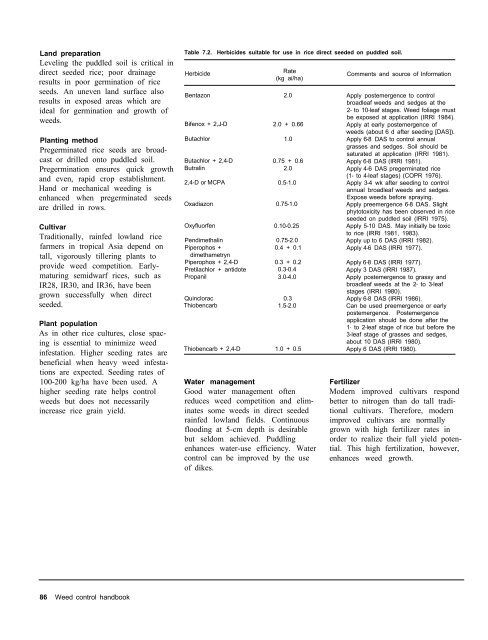A handbbok on Weed Control in Rice.pdf
A handbbok on Weed Control in Rice.pdf
A handbbok on Weed Control in Rice.pdf
Create successful ePaper yourself
Turn your PDF publications into a flip-book with our unique Google optimized e-Paper software.
Land preparati<strong>on</strong><br />
Level<strong>in</strong>g the puddled soil is critical <strong>in</strong><br />
direct seeded rice; poor dra<strong>in</strong>age<br />
results <strong>in</strong> poor germ<strong>in</strong>ati<strong>on</strong> of rice<br />
seeds. An uneven land surface also<br />
results <strong>in</strong> exposed areas which are<br />
ideal for germ<strong>in</strong>ati<strong>on</strong> and growth of<br />
weeds.<br />
Plant<strong>in</strong>g method<br />
Pregerm<strong>in</strong>ated rice seeds are broad-<br />
cast or drilled <strong>on</strong>to puddled soil.<br />
Pregerm<strong>in</strong>ati<strong>on</strong> ensures quick growth<br />
and even, rapid crop establishment.<br />
Hand or mechanical weed<strong>in</strong>g is<br />
enhanced when pregerm<strong>in</strong>ated seeds<br />
are drilled <strong>in</strong> rows.<br />
Cultivar<br />
Traditi<strong>on</strong>ally, ra<strong>in</strong>fed lowland rice<br />
farmers <strong>in</strong> tropical Asia depend <strong>on</strong><br />
tall, vigorously tiller<strong>in</strong>g plants to<br />
provide weed competiti<strong>on</strong>. Early-<br />
matur<strong>in</strong>g semidwarf rices, such as<br />
IR28, IR30, and IR36, have been<br />
grown successfully when direct<br />
seeded.<br />
Plant populati<strong>on</strong><br />
As <strong>in</strong> other rice cultures, close spac-<br />
<strong>in</strong>g is essential to m<strong>in</strong>imize weed<br />
<strong>in</strong>festati<strong>on</strong>. Higher seed<strong>in</strong>g rates are<br />
beneficial when heavy weed <strong>in</strong>festa-<br />
ti<strong>on</strong>s are expected. Seed<strong>in</strong>g rates of<br />
100-200 kg/ha have been used. A<br />
higher seed<strong>in</strong>g rate helps c<strong>on</strong>trol<br />
weeds but does not necessarily<br />
<strong>in</strong>crease rice gra<strong>in</strong> yield.<br />
86 <strong>Weed</strong> c<strong>on</strong>trol handbook<br />
Table 7.2. Herbicides suitable for use <strong>in</strong> rice direct seeded <strong>on</strong> puddled soil.<br />
Herbicide<br />
Bentaz<strong>on</strong><br />
Bifenox + 2,J-D<br />
Butachlor<br />
Butachlor + 2,4-D<br />
Butral<strong>in</strong><br />
2,4-D or MCPA<br />
Oxadiaz<strong>on</strong><br />
Oxyfluorfen<br />
Pendimethal<strong>in</strong><br />
Piperophos +<br />
dimethametryn<br />
Piperophos + 2,4-D<br />
Pretilachlor + antidote<br />
Propanil<br />
Qu<strong>in</strong>clorac<br />
Thiobencarb<br />
Thiobencarb + 2,4-D<br />
Rate<br />
(kg ai/ha)<br />
2.0<br />
2.0 + 0.66<br />
1.0<br />
0.75 + 0.6<br />
2.0<br />
0.5-1.0<br />
0.75-1.0<br />
0.10-0.25<br />
0.75-2.0<br />
0.4 + 0.1<br />
0.3 + 0.2<br />
0.3-0.4<br />
3.0-4.0<br />
0.3<br />
1.5-2.0<br />
1.0 + 0.5<br />
Water management<br />
Good water management often<br />
reduces weed competiti<strong>on</strong> and elim-<br />
<strong>in</strong>ates some weeds <strong>in</strong> direct seeded<br />
ra<strong>in</strong>fed lowland fields. C<strong>on</strong>t<strong>in</strong>uous<br />
flood<strong>in</strong>g at 5-cm depth is desirable<br />
but seldom achieved. Puddl<strong>in</strong>g<br />
enhances water-use efficiency. Water<br />
c<strong>on</strong>trol can be improved by the use<br />
of dikes.<br />
Comments and source of Informati<strong>on</strong><br />
Apply postemergence to c<strong>on</strong>trol<br />
broadleaf weeds and sedges at the<br />
2- to 10-leaf stages. <strong>Weed</strong> foliage must<br />
be exposed at applicati<strong>on</strong> (IRRI 1984).<br />
Apply at early postemergence of<br />
weeds (about 6 d after seed<strong>in</strong>g [DAS]).<br />
Apply 6-8 DAS to c<strong>on</strong>trol annual<br />
grasses and sedges. Soil should be<br />
saturated at applicati<strong>on</strong> (IRRI 1981).<br />
Apply 6-8 DAS (IRRI 1981).<br />
Apply 4-6 DAS pregerm<strong>in</strong>ated rice<br />
(1- to 4-leaf stages) (COPR 1976).<br />
Apply 3-4 wk after seed<strong>in</strong>g to c<strong>on</strong>trol<br />
annual broadleaf weeds and sedges.<br />
Expose weeds before spray<strong>in</strong>g.<br />
Apply preemergence 6-8 DAS. Slight<br />
phytotoxicity has been observed <strong>in</strong> rice<br />
seeded <strong>on</strong> puddled soil (IRRI 1975).<br />
Apply 5-10 DAS. May <strong>in</strong>itially be toxic<br />
to rice (IRRI 1981, 1983).<br />
Apply up to 6 DAS (IRRI 1982).<br />
Apply 4-6 DAS (IRRI 1977).<br />
Apply 6-8 DAS (IRRI 1977).<br />
Apply 3 DAS (IRRI 1987).<br />
Apply postemergence to grassy and<br />
broadleaf weeds at the 2- to 3-leaf<br />
stages (IRRI 1980).<br />
Apply 6-8 DAS (IRRI 1986).<br />
Can be used preemergence or early<br />
postemergence. Postemergence<br />
applicati<strong>on</strong> should be d<strong>on</strong>e after the<br />
1- to 2-leaf stage of rice but before the<br />
3-leaf stage of grasses and sedges,<br />
about 10 DAS (IRRI 1980).<br />
Apply 6 DAS (IRRI 1980).<br />
Fertilizer<br />
Modern improved cultivars resp<strong>on</strong>d<br />
better to nitrogen than do tall tradi-<br />
ti<strong>on</strong>al cultivars. Therefore, modern<br />
improved cultivars are normally<br />
grown with high fertilizer rates <strong>in</strong><br />
order to realize their full yield poten-<br />
tial. This high fertilizati<strong>on</strong>, however,<br />
enhances weed growth.











